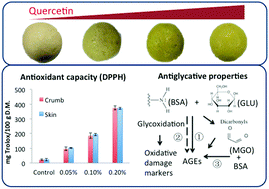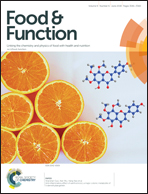Steamed bread enriched with quercetin as an antiglycative food product: its quality attributes and antioxidant properties†
Abstract
Quercetin, a natural antiglycative agent, was incorporated into steamed bread to produce a functional food that has high potential to lower the risk of diabetes. With the incorporation of quercetin at 1.20, 2.40, and 3.60%, the volume of steamed bread significantly decreased and the hardness of the crumb correspondingly increased with incremental quercetin content, while incorporation levels below 1.20% had no impact. Within this range of enrichment (1.2–3.6%), quercetin negatively affected the yeast activity with significantly less CO2 produced in dough during proofing. The wheat protein structure was altered by quercetin in terms of a higher level of β-sheets and a lower level of β-turns. The antioxidant capacity of the steamed bread with quercetin (0.05–0.2%) was significantly enhanced dose-dependently. A high inhibitory activity of quercetin-enriched steamed bread (0.05–0.2%) against fluorescent advanced glycation endproducts (AGEs) via several different mechanisms was observed. The inhibition of total AGEs from 0.2% quercetin-enriched steamed bread was around 40% during in vitro protein glycation. Overall, the results support quercetin-enriched steamed bread to be a promising functional food with high antioxidant and antiglycation properties.



 Please wait while we load your content...
Please wait while we load your content...